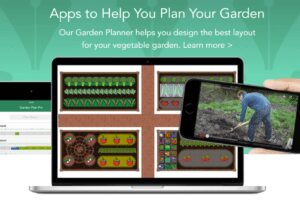“Anyone who thinks gardening begins in the spring and ends in the fall is missing the best part of the whole year; for gardening begins in January with a dream.” — Josephine Nuese
A cold, gray day. A cup of tea. My garden journal and stack of seed catalogs. It’s everything I need to start planning my garden for the coming season! Here are a few garden planning tips and ideas to get you started.
The Most Useful Tool in the Shed
The best gardening tool that I own isn’t made of steel, it’s made of paper – it’s my garden journal. Regardless of what form it takes for you – notebook, tablet, or recording – a journal will help track your garden’s progress over the season – and over the years.
Tip: If you haven’t already, start a journal now – it will be an invaluable resource for the future.
I jot notes at least weekly during the season, tracking weather, planting and harvesting data, and the all-important garden successes and failures. It’s also useful for remembering things you might otherwise forget, such as a plant variety or its location. I know it’s saved me a time or two!
Without a doubt, having past information about your garden is very helpful in planning the coming year.
A Look Back
For me, the first planning step is to review last year’s garden. You need to know where you’ve been to see where you are going!
Whether you’ve journaled or not, these questions will help set a framework for this year’s garden.
- What were your garden successes last year?
- What made them a success? (It’s okay to say “luck!”)
- What challenges did you face?
- What was a failure? (We ALL have them!)
- What could you have done better or differently?
- What did you grow too much of?
- What did you wish you had grown more of?
Tip: Take photos of your garden to supplement your journal.
Dream A Little
As you make your garden plan, I encourage you to dream a little and create a wish-list. You only need click on Pinterest for loads of inspiration for garden design, structures, and plantings.
Vision boards are another creative outlet for getting your ideas down. Find an online app (search “online vision boards”) or go traditional by pasting images on poster board. It’s a fun and clever way to see your wish-list and goals.
A Look Forward
Next, transform a few of those inspirational ideas into actions. For this year’s garden:
- What do you want to grow?
- How can you grow more efficiently? (More/less space, growing vertically, containers?)
- What needs to be changed or updated in the garden?
Draw from your garden review and your wish-list to answer these. If the last question becomes a long list, prioritize the “must-do” action items from the “would-like-to-do” wish-list items.
Tip: Keep your planning process fun and view it as a work in progress.
Creating a Garden Layout
Before the trowel ever breaks soil, you should have a layout of your garden. Thankfully, you don’t have to be a landscape architect to do this. I prefer a simple sketch, but there are some great online tools available too. GrowVeg.com is an excellent paid option.
Consider these as you design your garden:
- Crop rotation: Review what and where you planted crops last year, then plan to rotate those crops to a different location this year. Rotating crops helps limit diseases, insect infestation, and helps with soil fertility. This can be challenging for small space gardens, but do your best not to grow the same plant in the same location year after year.
- Seed saving: Plan for isolation distances between varieties to avoid cross-pollination. Most vegetables require a minimum of 10 feet between cross-pollinating species.
- Succession planting: When one crop is finished producing, remove it and plant something else. Charting vegetable days-to-maturity and harvest dates allow you to get the most from your garden.
Tip: Consider growing more vegetables in containers. It a great solution for crop rotation and seed saving.
Organize and Inventory Seed and Supplies
At this point you’ll probably have a good idea of what your garden will look like this year. Now it’s time to do a little pre-season prep work.
With gardening’s popularity skyrocketing, I recommend purchasing seeds and supplies before the season gets underway. But first, take inventory of what’s on hand.
Most seed when properly stored (cool, dry, dark place), will last for at least two years. Check the “packed for” date and seed quantities. If you’re uncertain of the quality or don’t know how long the seed has been around, do a quick germination test. Read detailed information on germination testing and get a seed viability chart here.
Next, inventory seed starting supplies, such as starting mix, grow trays and pots, heat mats, and lights. If you are reusing trays and pots, clean them with warm soapy water, then soak in a weak bleach solution (2 TBS bleach to 1 gallon water) for about 15 minutes, and air dry. Check that heat mats and lights are working.
Tip: Purchase seed and supplies now. Many items will be sold out by spring.
I hope these tips inspire you to start planning your garden and I’d love to hear what your plans are for this year. Leave me a comment below!







Leave a Reply